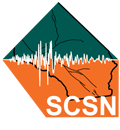Bombay Beach Earthquake Swarm Continues
Report by the California Integrated Seismic Network (Caltech/USGS) – Anthony Guarino, Egill Hauksson, Kate Hutton, Ellen Yu, Seismological Laboratory, Caltech, and Bob Dollar, Doug Given, Susan Hough, Ken Hudnut, and Lucy Jones, USGS.
UPDATE 04/02/2009
The following plot shows the development of the Bombay Beach earthquake swarm with time, as of this morning. It is clear that the activity has quieted down significantly since last week. In the upper plot, each "stick" represents an earthquake. The height of the stick represents the magnitude & the horizontal position represts the time. The second plot depicts the same information, but in terms of the cumulative number of events. This representation makes it easy to see the changes in rate, from the slope of the graph.
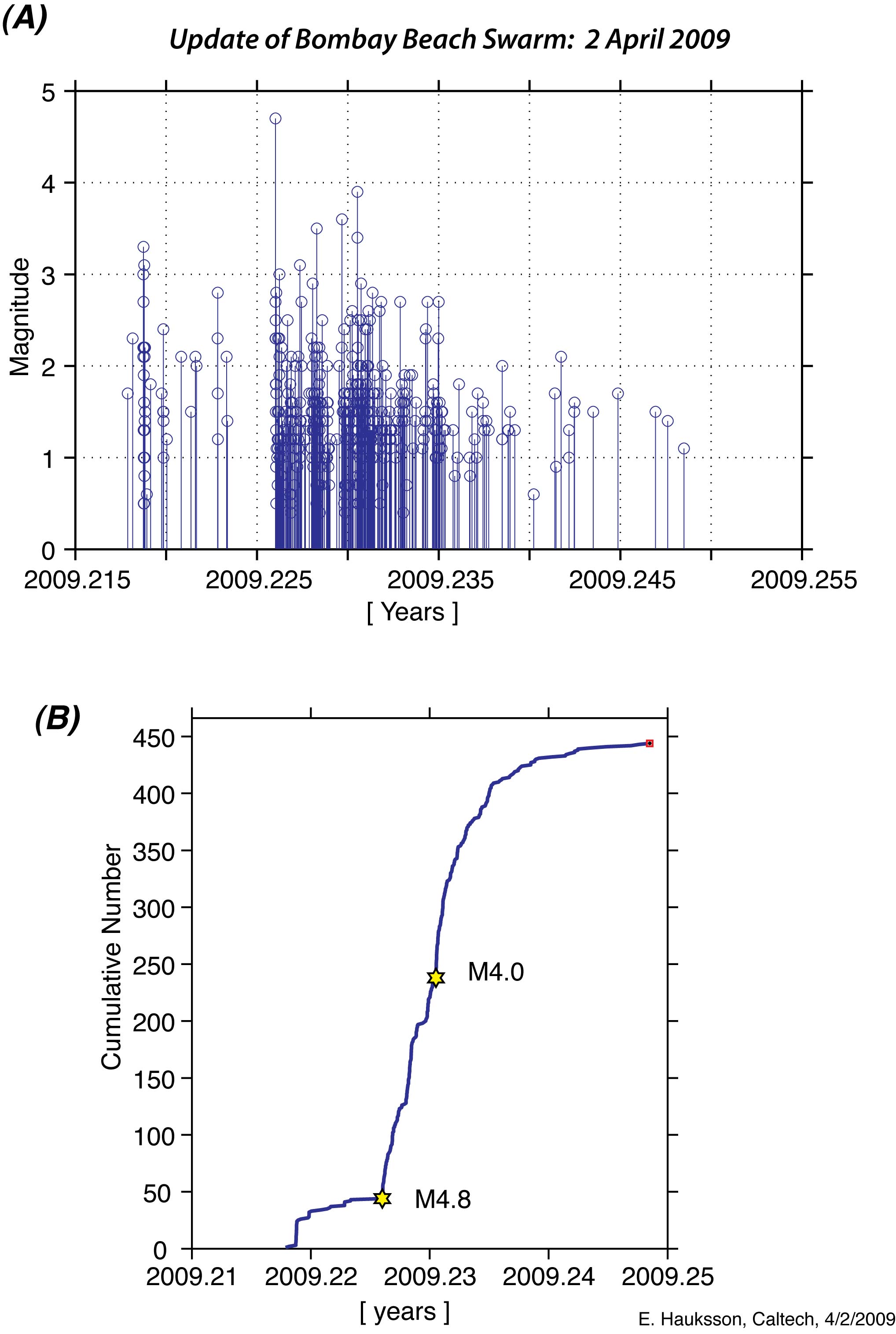
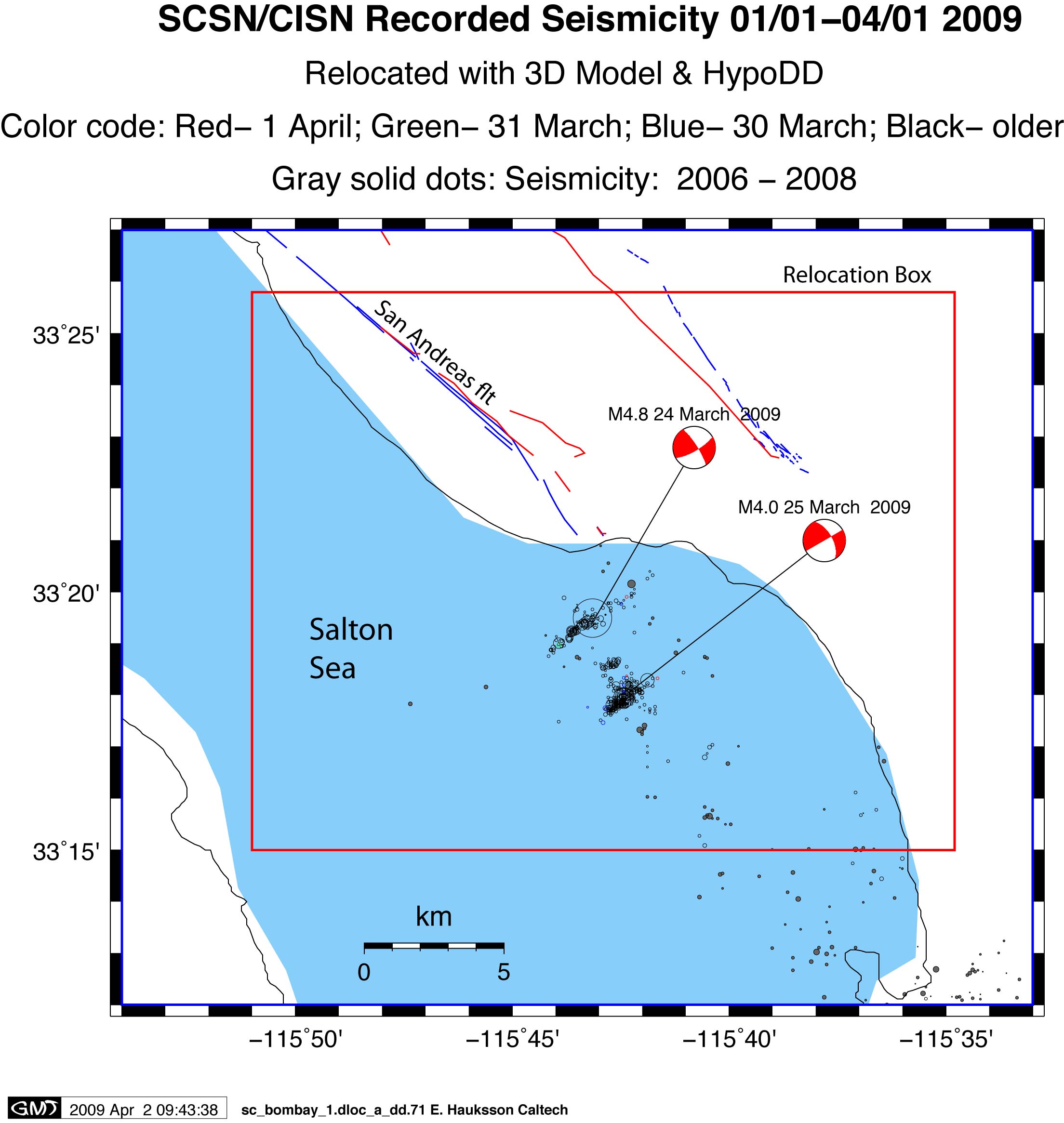
UPDATE 03/27/09
The image above shows new relocations for events up to March 27 at 9:13AM PDT. Relocations are located using the Hauksson-Shearer method.
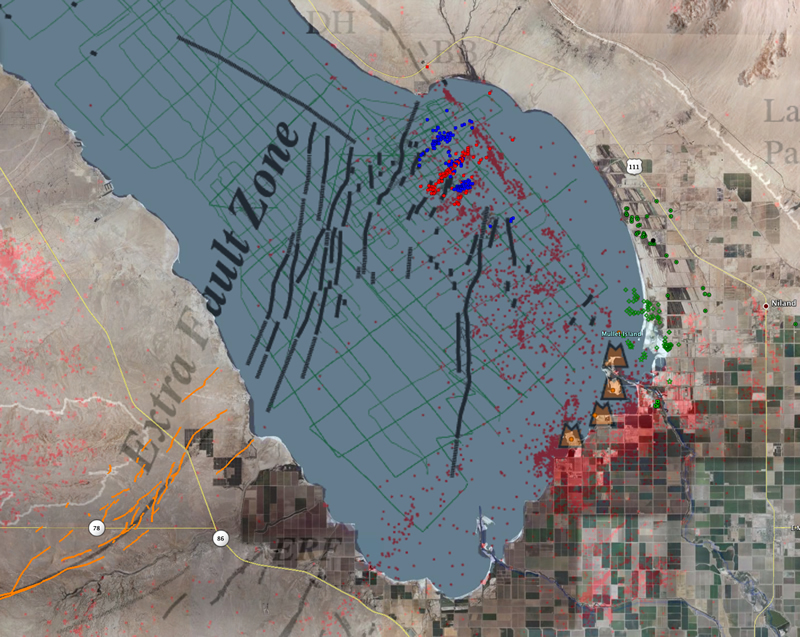
UPDATE 03/26/09
The earthquake swarm near Bombay Beach in the Salton Sea area continues through today, with additional events larger than M3.0 still occurring. The largest event within the last 24 hours was a M4.0 at 20:25PDT. This event was felt throughout the Coachella Valley, and has been reviewed by a seismologist. So far, there have been more than 250 events total located during this swarm, ranging from M0.8-M4.8. Further updates from SCSN will follow as the swarm continues.
Above: Plots of relocated events in current swarm (green, red, and purple) with background seismicity (blue) relocated using the Huaksson-Shearer method. Image created by Bob Dollar.
The following table lists all events M3 and larger that have occurred during this swarm:
| EvID | Mag | YYYY/MM/DD HH:mm:SS | Lat | Lon | Depth | Location |
|---|---|---|---|---|---|---|
| 14432456 | 3.1 | 3/21/2009 13:12:18 | 33 18.8 N | 115 43.8 W | 4.7 | 4 km (3 mi) S of Bombay Beach, CA |
| 14432496 | 3.3 | 3/21/2009 13:17:03 | 33 18.9 N | 115 44 W | 4.7 | 4 km (2 mi) S of Bombay Beach, CA |
| 14432576 | 3.1 | 3/21/2009 13:40:06 | 33 18.9 N | 115 44 W | 4.9 | 4 km (2 mi) S of Bombay Beach, CA |
| 14433456 | 4.8 | 3/24/2009 4:55:43 | 33 19.1 N | 115 43.7 W | 5.8 | 4 km (2 mi) S of Bombay Beach, CA |
| 14433696 | 3.1 | 3/24/2009 6:52:51 | 33 18.8 N | 115 44.2 W | 4.2 | 4 km (2 mi) S of Bombay Beach, CA |
| 14434264 | 3.1 | 3/24/2009 16:43:15 | 33 18.4 N | 115 44.6 W | 5 | 5 km (3 mi) S of Bombay Beach, CA |
| 14434504 | 3 | 3/24/2009 22:50:55 | 33 17.4 N | 115 43.5 W | 6 | 7 km (4 mi) S of Bombay Beach, CA |
| 14434688 | 3.6 | 3/25/2009 0:51:23 | 33 17.4 N | 115 43.3 W | 4.4 | 7 km (4 mi) S of Bombay Beach, CA |
| 14435296 | 3.7 | 3/25/2009 12:59:44 | 33 17.5 N | 115 43.2 W | 6.5 | 7 km (4 mi) S of Bombay Beach, CA |
| 14435776 | 4 | 3/25/2009 20:25:21 | 33 17.6 N | 115 43.3 W | 7.4 | 6 km (4 mi) S of Bombay Beach, CA |
| 10111842 | 3.4 | 3/25/2009 20:25:50 | 33 18.1 N | 115 42.4 W | 5 | 6 km (4 mi) SSE of Bombay Beach, CA |
| 14436024 | 3 | 3/25/2009 22:12:33 | 33 17.5 N | 115 43.1 W | 11 | 7 km (4 mi) SSE of Bombay Beach, CA |
The following graphs are up to date as of 3/25/09:
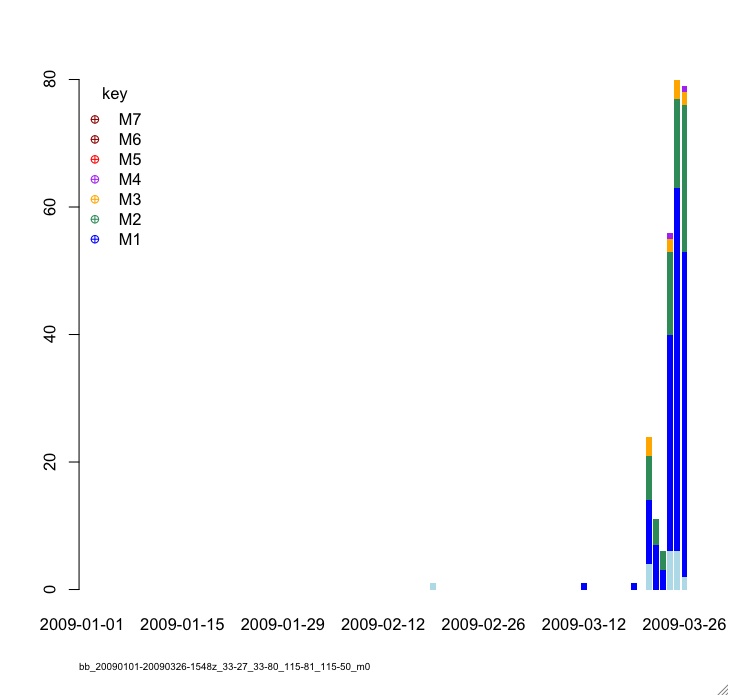
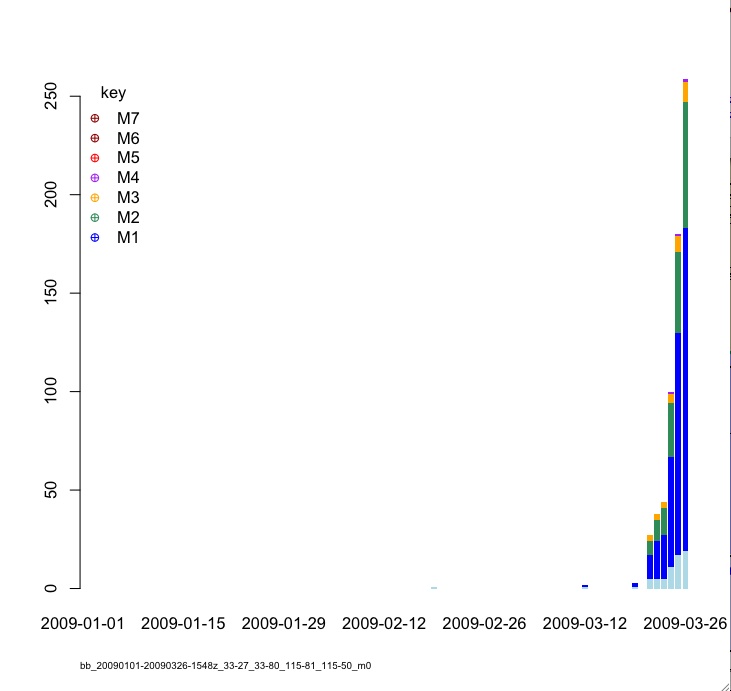
Bombay Beach Earthquake Swarm at 10:00:00AM on 03/24/08
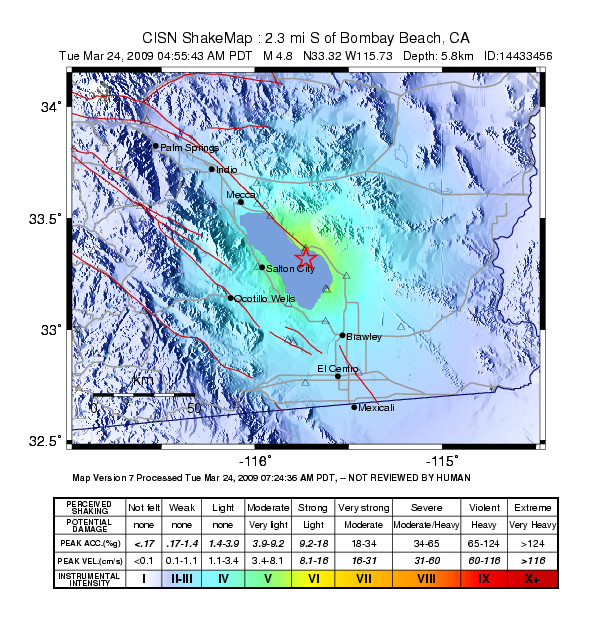
An earthquake swarm near Bombay Beach in the Salton Sea area began on March 21st, 2009, with a M1.8 earthquake, located 3km SSE of Bombay Beach. The swarm has continued through today, with the largest event having occurred yesterday morning at 04:55AM PDT, a M4.8 earthquake, located 4km S of Bombay Beach. So far, there have been more than 250 events between M0.8 and M4.8, and the events continue through 3/25/09, despite a five-hour lull in activity from 06:47PDT through 11:41PDT on 3/25/09.
The M4.8 moment tensor solution displays strike-slip motion, with the preferred nodal plane strike of N57E, with an uncertainty of 8 degrees. This is consistent with a fault or faults orthogonal to the San Andreas fault, located in the northern Brawley Seismic Zone. As time has progressed, the events have migrated slightly southeast. Before 2001, there were few events that had occurred in the northern Brawley Seismic Zone. The southern Brawley Seismic Zone is much more active, with events occurring on a regular basis.
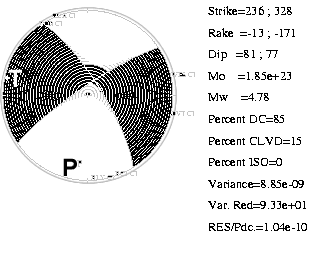
From 1932 to 2008, we recorded 722 events within a 5km radius of this current swarm. Most of the historical events recorded within 5 km of the current swarm were portions of earlier Bombay Beach swarms. Historically, the larger events (>M3.0) occurred less frequently, but still total 22. Prior to this sequence, the largest event recorded in this 5km region of Bombay Beach was a M4.2 earthquake. This event occurred on 11/13/99, and was triggered by the Hector Mine Earthquake, which occurred on 10/16/1999. The list of current events for the swarm can be viewed below. We will continue to monitor the area, and post any new information here at SCSN.org.
The Hauksson-Shearer relocations of historical events (in white) display a ladder-type structure in the plan view, with the current sequence at the northwesternmost portion of the zone. These southwest to northeast trending events may be an extension of the Extra fault zone (shown in orange), but is more commonly referred to as the Brawley Seismic Zone.
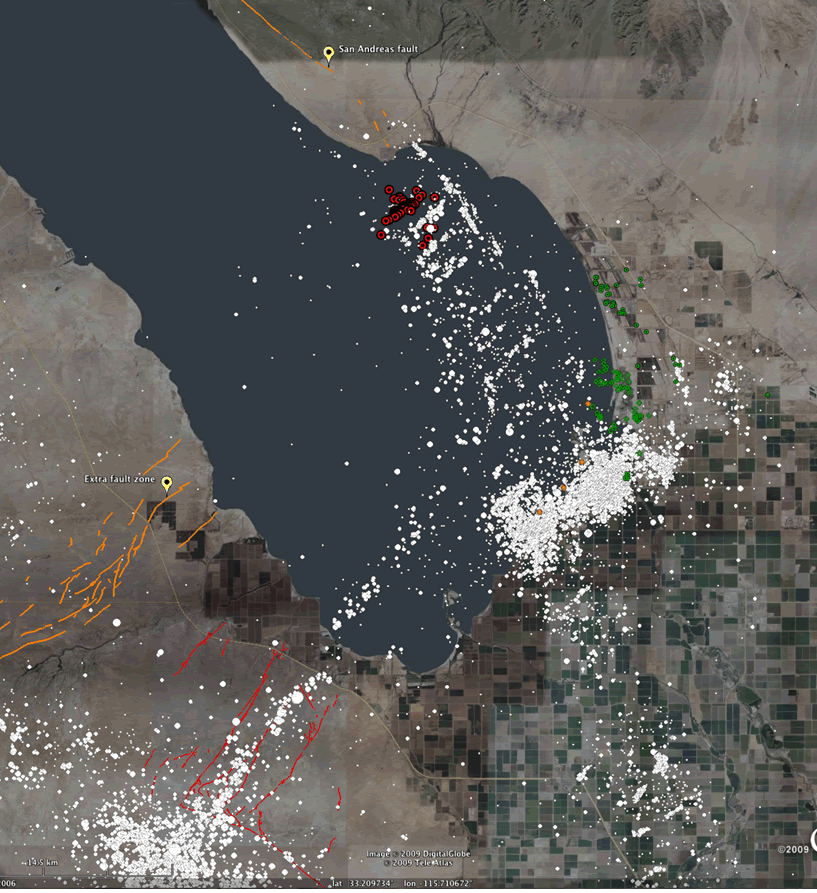
The latest events are shown as red circles (precisely re-located as of 3/24/09 noon local time by Egill Hauksson of Caltech). The activity occurred near the intersection of the San Andreas fault and the northeastward projection of the Extra fault zone, near the northern end of the Brawley Seismic Zone. This area has been seismically active previously in Oct. 1999 (Hough and Kanamori, 2002) and Nov. 2001. It has also been noted as being potentially significant for future rupture of the southern San Andreas fault (e.g., Hudnut et al., 1989). Active faults are shown in red if they have ruptured historically (the Elmore Ranch fault zone broke in Nov. 1987, and the Coyote Creek fault broke in 1968). Also shown in orange are faults that have been mapped and that have exhibited triggered creep during regional earthquakes. These include the San Andreas fault and Extra fault zone [data of Susanne U. Janecke, unpublished mapping, Kirby 2005 MS thesis, and Kirby et al. (2007). Additional faults are being mapped.] Other features shown are volcanic centers (orange circles) and various mud pots, carbon dioxide vents (green symbols; from Lynch & Hudnut, 2008).
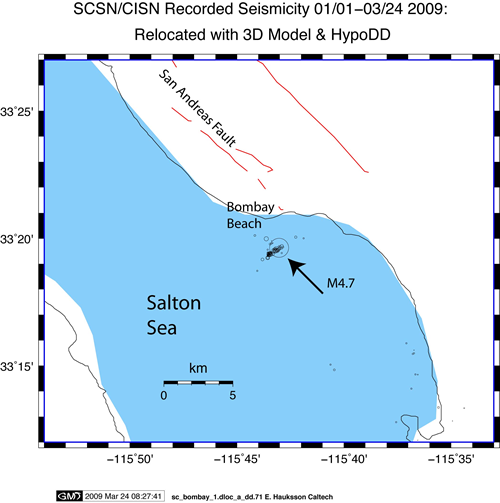
The image above shows the events which have been re-located using the Hauksson/Shearer method. Note that the events create a linear feature orthogonal to the San Andreas fault.
The following table lists all events M3 and larger that have occurred during this swarm:
| EvID | Mag | YYYY/MM/DD HH:mm:SS | Lat | Lon | Depth | Location |
|---|---|---|---|---|---|---|
| 14432456 | 3.1 | 3/21/2009 13:12:18 | 33 18.8 N | 115 43.8 W | 4.7 | 4 km (3 mi) S of Bombay Beach, CA |
| 14432496 | 3.3 | 3/21/2009 13:17:03 | 33 18.9 N | 115 44 W | 4.7 | 4 km (2 mi) S of Bombay Beach, CA |
| 14432576 | 3.1 | 3/21/2009 13:40:06 | 33 18.9 N | 115 44 W | 4.9 | 4 km (2 mi) S of Bombay Beach, CA |
| 14433456 | 4.8 | 3/24/2009 4:55:43 | 33 19.1 N | 115 43.7 W | 5.8 | 4 km (2 mi) S of Bombay Beach, CA |
| 14433696 | 3.1 | 3/24/2009 6:52:51 | 33 18.8 N | 115 44.2 W | 4.2 | 4 km (2 mi) S of Bombay Beach, CA |
| 14434264 | 3.1 | 3/24/2009 16:43:15 | 33 18.4 N | 115 44.6 W | 5 | 5 km (3 mi) S of Bombay Beach, CA |
| 14434504 | 3 | 3/24/2009 22:50:55 | 33 17.4 N | 115 43.5 W | 6 | 7 km (4 mi) S of Bombay Beach, CA |
| 14434688 | 3.6 | 3/25/2009 0:51:23 | 33 17.4 N | 115 43.3 W | 4.4 | 7 km (4 mi) S of Bombay Beach, CA |
| 14435296 | 3.7 | 3/25/2009 12:59:44 | 33 17.5 N | 115 43.2 W | 6.5 | 7 km (4 mi) S of Bombay Beach, CA |
| 14435776 | 4 | 3/25/2009 20:25:21 | 33 17.6 N | 115 43.3 W | 7.4 | 6 km (4 mi) S of Bombay Beach, CA |
| 10111842 | 3.4 | 3/25/2009 20:25:50 | 33 18.1 N | 115 42.4 W | 5 | 6 km (4 mi) SSE of Bombay Beach, CA |
| 14436024 | 3 | 3/25/2009 22:12:33 | 33 17.5 N | 115 43.1 W | 11 | 7 km (4 mi) SSE of Bombay Beach, CA |
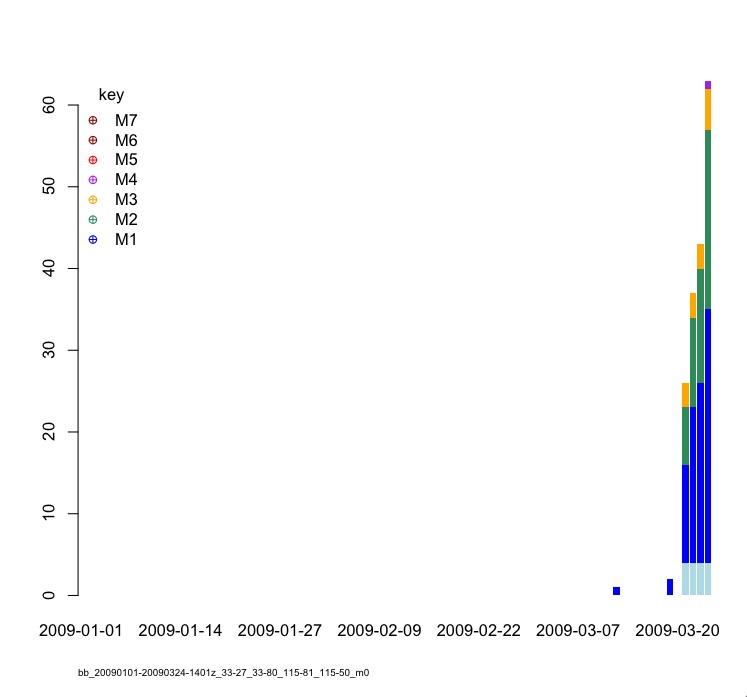
The graphs above represent the swarm and are color-coded by magnitude:
References:
- Hough, S. E., Kanamori, H. Source Properties of Earthquakes near the Salton Sea Triggered by the 16 October 1999 M 7.1 Hector Mine, California, Earthquake, Bull. Seis. Soc. Amer. 92: 1281-1289, 2002
- Hudnut, K.W., L. Seeber, and J. Pacheco, Cross-fault triggering in the November 1987 Superstition Hills earthquake sequence, southern California, Geophys. Res. Lett., v. 16, No. 2, pp. 199-202, 1989
- Kirby, S.M., 2005, The Quaternary tectonic and structural evolution of the San Felipe Hills, California, [M.S. Thesis]: Logan, Utah State University, 182 p.
- Kirby, S.M., Janecke, S.U., Dorsey, R.J., Housen, B.A., McDougall, K., Langenheim, V., and Steely, A. Jan 2007, Pleistocene Brawley and Ocotillo formations: Evidence for initial strike-slip deformation along the San Felipe and San Jacinto fault zones, California: Journal of Geology, v. 115, p. 43-62.
- Lin, G., P. Shearer and E. Hauksson (2007), Applying a three-dimensional velocity model, waveform cross correlation, and cluster analysis to locate southern California seismicity from 1981 to 2005, J. Geophys. Res., 112, B12309, doi:10.1029/2007JB004986
- Lynch, D. K. and K. W. Hudnut, The Wister Mud Pot Lineament: Southeastward Extension or Abandoned Strand of the San Andreas Fault? Bull. Seis. Soc. Amer. , Vol. 98, No. 4, pp. 1720-1729, doi: 10.1785/0120070252, 2008
